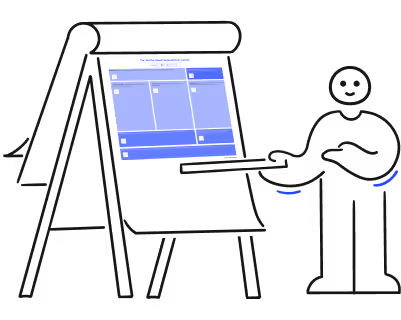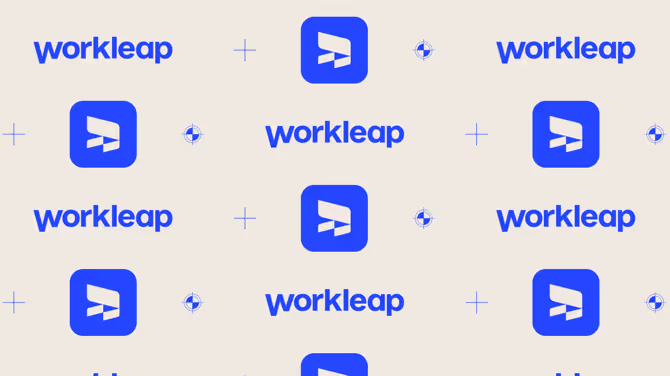Improve your employees' productivity through online training

Empower your organization with the skills-based canvas.

Running a business is difficult. Let's not kid ourselves.
Internet, however, allows us to simplify our personal and professional lives on a daily basis. It has never been easier to find new suppliers, partners, complementary products and potential customers than now.
Information is now at our fingertips, so long as you know how to use it, and you are open to leveraging it!
This ease of access to strategic information can be a game-changer in the growth strategy of a company, which nowadays is closely related to staff retention and development challenges. Whether through a culture of self-training or personalized learning paths, industry leaders now all use technology as an engine of growth.
Why? Because training your employees is also about creating value.
1. Major wins at a low cost
Whether with formal or informal learning, leading companies are using technology to drive growth.
There is a gap between proactive and change-resistant companies; let's see how corporate online training directly impacts your employees' productivity and ensures the success of tomorrow's giants.
Whether at the end of the budget year or on an ongoing basis, investing in your internal training structure is one of the foundations of sound business management.
Depending on your budget, the digital implementation of standards for your processes can take shape quickly and generate short-term improvements.
What if you trained your new employees with online training?
For example, the online onboarding process could save your employees up to 30% of the time normally required to onboard a new employee! And you could even accelerate and simplify your onboarding content creation by filming dynamic onboarding videos that require little effort and few resources!
Did you know that it takes an average of 3 months for your new employees to be profitable and autonomous? While investments in human resources are contested in some companies, the implementation of an online training structure allows you to make gains with ease.
2. Employee experience through online training
Unlike the traditional training approach, which often aims to condense as much information as possible over a short period of time, online training helps put your employees in a winning position to retain more information.
Since online courses are no longer restricted to your trainers' availabilities, it is now possible for you to improve the experience-employee and to offer drip content to improve their interest and engagement. This approach aims to make the content progressively accessible over a predefined period of time.
Your employees can therefore put each of the learnings into practice more quickly, without being saturated by the information that their trainer gives them.
The onboarding plan for a new employee becomes more efficient and the work of your teams more effective. Each learning period is also an opportunity for personalized and specific coaching for those who may need additional support.
To further personalize their training, you can even offer your employees customized learning paths!
3. Encourage internal recruitment
One of the most costly factors for business growth is the investment required in new resources training.
While a large part of the annual HR budget is cut by the sourcing, onboarding and integration expenses designed to empower new employees. A culture of self-training can generate two major impacts on the recruitment needs of a company.
First and foremost, this approach allows your best employees to stand out and prepare themselves for future opportunities for advancement within the business.
Secondly, this allows you to more easily identify your brand ambassador and recruit internally, both in the form of promotion or transversal recruitment within the company. When occasional needs lead to work overload in a department, an online training structure can allow you to easily transfer employees.
4. Develop trust and better relationships in your business
In opposition to popular belief, a good online training offer can improve the relationship between employees and the employer.
Offering a skills development strategy, via a learning management system (LMS), frees up time in your schedule and generates more opportunities for personalized follow-ups.
Your best employees can swiftly get back to work, while employees with special needs can now benefit from value-added availability with a trainer or in-house experts.
This will generate more discussions, employee interactions and practical reflections. Your new employees will feel cared for and valued, while your trainers will be more motivated to help, as this approach saves them from always repeating the same things.
By encouraging your employees to use your LMS and take personal notes, each employee can build his own "survival guide" and easily trace back information when need be. As a manager, you should always be on the lookout for new ways to make your new employees autonomous and self-aware of their development needs.
To wrap things up, as we said in our opening, running a business is difficult.
This is particularly true when we refuse to adapt and try to deny the evolution of our market. What sets successful companies apart from those that fail is their openness to change and the speed with which they take action to ride the waves rather than row back and try to catch up on best practices.
This is also called innovation if you are the first in your field to make a move.
Corporate online training is both what adds value to your business and in the eyes of your customers, but it is also what keeps your teams motivated and committed to organizational success.
It's a smart financial investment, but more importantly, it's a very strategic investment in your employees of today and tomorrow.
Discover, manage, and grow your team’s skills to unleash their potential and retain your rising stars.


%20(1).avif)


.avif)
.avif)
%202.avif)







